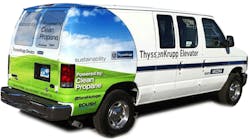Is it clean? Does it conserve? Is it cost-effective? Does it make common sense? And can you commit? ThyssenKrupp needed answers. The Alpharetta, GA-based firm found the right answers in the form of propane autogas.
“We are challenged in today’s marketplace to go green,” says Tom Armstrong, director of fleet. “We were determined to reduce our fuel consumption and find sustainable vehicles that worked for us. With all the alternative fuel choices available today, we needed a tool to effectively analyze and justify each fuel or alternative fuel vehicle type.
“When we laid out all the fuels available, including propane autogas, ethanol, biodiesel, compressed natural gas, and electric, there was only one alternative fuel source that had a check mark in all five categories and that was propane autogas,” he adds.
ThyssenKrupp started small, with just three vehicles initially, but has since grown its propane autogas fleet, powered by Roush CleanTech systems, to include three Ford F-150 trucks, four F-250 trucks, one Ford E-450 utility body van, two E-250 vans, and 44 E-150 vans. Ultimately, the company plans to convert 10% of its fleet, or about 300 vehicles, to propane autogas by 2015, utilizing both public and private refueling stations.
Accordingly, the switch to propane autogas has paid dividends, with a per gallon cost savings of $1.91 resulting in $4,152 per vehicle, per year in fuel savings. There is also an elimination of 6,917 lbs. of carbon dioxide per vehicle, per year based on the company’s 25,000-mi. annual vehicle average. In all, the company estimates it eliminates 373,518 lbs. of carbon dioxide annually.
Roush CleanTech says propane autogas emits up to 25% less greenhouse gases, about 20% less nitrogen oxide, and up to 60% less carbon monoxide when compared to gasoline. The first vehicles put into operation by ThyssenKrupp were three Roush CleanTech Ford E-150 propane autogas vans in Phoenix in 2010. Armstrong says the average price for gasoline in the Phoenix area this year has been $3.84/gal. compared to $1.93/gal. for propane autogas, resulting in a $224,208 fuel cost savings in that market alone.
“The return on investment for our propane autogas vehicles varies city by city, based on a number of variables including state incentives, fuel costs reduction, high occupancy vehicle (HOV) lane access, and registration costs,” Armstrong says. “For example, our cost benefits in the Phoenix region are tied to lower fuel and vehicle registration costs, and also HOV lane access. We have found our rate of return is roughly two to four years per vehicle. With an estimated six-year vehicle life, we have at least two years of positive return on our investment per vehicle.”
ThyssenKrupp also operates propane autogas vehicles in Seattle, Los Angeles, San Diego, and Detroit with Dallas, Houston, Sacramento, and San Francisco next on the deployment list.
Because drivers oftentimes take vehicles home so they can address customer emergencies as they arise, refueling posed an initial dilemma. In the Detroit market, ThyssenKrupp built its own refueling infrastructure, however, planning was needed for the remaining cities to ensure drivers not only had access to propane autogas fueling stations but 24/7 access with credit card capability.
To address this, the company enters a driver’s home address into software that maps out the exact location of fueling stations in the area. “When we first started out, we were looking to reduce the company’s carbon footprint by 20% by the end of 2015, with an interim goal of 12% improvement in fuel efficiency by 2012,” explains Armstrong. “We have already met both of those goals and couldn’t be more pleased with how propane autogas is performing for us.”




